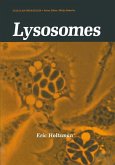Lysosomes and their equivalent structures (known as vacuoles in yeast and plant cells) have long been established as the degradative end points for both intracellular and exogenous cargo. The catabolic function of the lysosome is accomplished by an array of approximately 60 proteases, lipases, nucleases and other hydrolytic enzymes that break down complex macromolecules into their constituent building blocks Tay-Sachs disease is a genetic disorder that results in the destruction of nerve cells in the brain and spinal cord. It is inherited from a person's parents in an autosomal recessive manner. The mutation results in problems with an enzyme called beta-hexosaminidase A which results in the build-up of the molecule GM2 ganglioside within cells, leading to toxicity. The development of enzyme replacement therapy (ERT) is apromising option for the treatment of lysosomal storage diseases.
Bitte wählen Sie Ihr Anliegen aus.
Rechnungen
Retourenschein anfordern
Bestellstatus
Storno








